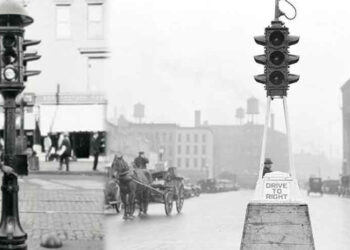On August 5, 1914, Cleveland, Ohio, witnessed a revolutionary development in urban transportation: the installation of the world’s first electric traffic signal. This historic event not only marked the beginning of modern traffic management but also set the stage for the sophisticated systems we rely on today.
A Chaotic Era of Traffic Control
Before this groundbreaking invention, managing traffic was a daunting task. Police officers stood at intersections, using hand signals to direct the growing number of vehicles. This manual system was fraught with inefficiencies and prone to human error, particularly as automobiles became more common.
James Hoge: The Visionary Inventor
Enter James Hoge, an innovative American inventor who recognized the need for a more reliable traffic control method. Hoge’s vision was to automate the process, reducing accidents and improving traffic flow. His solution? An electric traffic signal that would forever change urban mobility.
The Historic Installation
On that fateful day in 1914, the first electric traffic signal was installed at the bustling intersection of East 105th Street and Euclid Avenue in Cleveland. Unlike today’s automated systems, this early traffic light was manually operated by a police officer stationed in a nearby booth. It featured two lights: red for stop and green for go, a simple yet effective system that immediately proved its worth.
Transforming Urban Traffic Management
The success of Cleveland’s electric traffic signal quickly caught the attention of cities across the United States. It wasn’t long before similar systems were adopted nationwide and eventually worldwide. Hoge’s invention drastically reduced intersection accidents, streamlined traffic flow, and laid the foundation for the standardized traffic control systems we see today.
A Lasting Legacy
Today’s traffic signals, equipped with sensors, timers, and computer algorithms, are far more advanced. However, they still adhere to the fundamental principles established by Hoge’s pioneering design. His invention not only improved safety and efficiency but also became an integral part of urban infrastructure, demonstrating the power of innovation to solve pressing real-world problems.
Conclusion
The installation of the first electric traffic signal on August 5, 1914, in Cleveland, Ohio, was a landmark moment in transportation history. James Hoge’s innovative spirit and practical approach to a growing urban challenge have left a lasting legacy, shaping how we navigate city streets over a century later. This simple yet profound invention remains a testament to the impact of creative problem-solving and technological advancement.
References:











